Silicon Self-Switching Diode (SSD) as a Full-Wave Bridge Rectifier in 5G Networks Frequencies
Abstract
:1. Introduction
| Rectifier | Frequency | Fabrication Process Steps | Simulation/ Fabrication | References |
|---|---|---|---|---|
| Schottky barrier diode Bridge rectifier | 2.45 GHz | - | Simulation | [23] |
| Schottky barrier diode bridge rectifier | 100 MHz 2.45 GHz | - | Simulation | [24] |
| NMOS bridge rectifier | 13.56 MHz | - | Simulation | [25] |
| SOI CMOS bridge rectifier | 2.45 GHz | - | Simulation | [26] |
| Integrated 4H-Silicon Carbide diode bridge rectifier | - | etching, annealing, patterning and metal deposition | Fabrication | [27] |
| GaAs Schottky diodes bridge rectifier | - | heavily doping, lightly doping, etching and metal deposition | Fabrication | [28] |
| Oxide TFT Rectifiers | - | multi dry etching, multi deposition | Fabrication | [29] |
2. Materials and Methods
3. Results and Discussion
3.1. The Mechanism of the SSD Full-Wave Bridge Rectifier
3.2. I-V Characteristics of the SSD Full-Wave Bridge Rectifier
3.3. Rectification of the SSD Full-Wave Bridge Rectifier
3.4. Cut-Off Frequency of the SSD Full-Wave Bridge Rectifier
4. Conclusions
Author Contributions
Funding
Institutional Review Board Statement
Informed Consent Statement
Data Availability Statement
Acknowledgments
Conflicts of Interest
References
- Andrews, J.G.; Buzzi, S.; Choi, W.; Hanly, S.V.; Lozano, A.; Soong, A.C.; Zhang, J.C. What will 5G be? IEEE J. Sel. Areas Commun. 2014, 32, 1065–1082. [Google Scholar] [CrossRef]
- Pradhan, D.; Sahu, P.K.; Dash, A.; Tun, H.M. Sustainability of 5G Green Network toward D2D Communication with RF-Energy Techniques. In Proceedings of the 2021 International Conference on Intelligent Technologies (CONIT), Hubli, India, 25–27 June 2021. [Google Scholar] [CrossRef]
- Poongodi, T.; Krishnamurthi, R.; Indrakumari, R.; Suresh, P.; Balusamy, B. Wearable devices and IoT. In Intelligent Systems Reference Library; Springer Science and Business Media Deutschland GmbH: Berlin/Heidelberg, Germany, 2020; Volume 165, pp. 245–273. [Google Scholar] [CrossRef]
- Singh, H.; Pallagani, V.; Khandelwal, V.; Venkanna, U. IoT based smart home automation system using sensor node. In Proceedings of the 4th IEEE International Conference on Recent Advances in Information Technology, RAIT 2018, Dhanbad, India, 15–17 March 2018; pp. 1–5. [Google Scholar] [CrossRef]
- Cao, Y.; Zhong, Y.; Peng, C.; Peng, X.; Pan, S. Energy Efficiency Optimization for SWIPT-Enabled IoT Network with Energy Cooperation. Sensors 2022, 22, 5035. [Google Scholar] [CrossRef] [PubMed]
- Babaei, M.; Durak-Ata, L.; Aygölü, Ü. Performance Analysis of Dual-Hop AF Relaying with Non-Linear/Linear Energy Harvesting. Sensors 2022, 22, 5987. [Google Scholar] [CrossRef] [PubMed]
- Ding, Z.; Krikidis, I.; Sharif, B.; Poor, H.V. Wireless information and power transfer in cooperative networks with spatially random relays. IEEE Trans. Wirel. Commun. 2014, 13, 4440–4453. [Google Scholar] [CrossRef] [Green Version]
- Zakaria, N.F.; Kasjoo, S.R.; Isa, M.M.; Zailan, Z.; Arshad, M.K.M.; Taking, S. Self-switching diodes as RF rectifiers: Evaluation methods and current progress. Bull. Electr. Eng. Inform. 2019, 8, 396–404. [Google Scholar] [CrossRef]
- Jamalullail, N.; Mohamad, I.S.; Norizan, M.N.; Mahmed, N.; Taib, B.N. Recent improvements on TiO 2 and ZnO nanostructure photoanode for dye sensitized solar cells: A brief review. EPJ Web Conf. 2017, 162, 01045. [Google Scholar] [CrossRef] [Green Version]
- Norhisamudin, N.A.; Sabani, N.; Rosli, N.; Ahmad, M.F.; Juhari, N.; Shaari, S.; Zakaria, N. The efficiency effect of dye sensitized solar cell using different ratio of organic polymer doped titanium dioxide at different annealing process temperature. AIP Conf. Proc. 2020, 2203, 020052. [Google Scholar]
- Puluckul, P.P.; Weyn, M. Battery-Less Environment Sensor Using Thermoelectric Energy Harvesting from Soil-Ambient Air Temperature Differences. Sensors 2022, 22, 4737. [Google Scholar] [CrossRef]
- Nasir, A.A.; Zhou, X.; Durrani, S.; Kennedy, R.A. Relaying protocols for wireless energy harvesting and information processing. IEEE Trans. Wirel. Commun. 2013, 12, 3622–3636. [Google Scholar] [CrossRef] [Green Version]
- Murad, S.A.Z.; Ahmad, M.F.; Mazalan, M.; Shahimin, M.M.; Rais, S.A.A.; Norizan, M.N. A design of 5.2 GHz CMOS up-conversion mixer with if input active balun. In Proceedings of the ISWTA 2011—2011 IEEE Symposium on Wireless Technology and Applications, Langkawi, Malaysia, 25–28 September 2011; pp. 1–4. [Google Scholar] [CrossRef]
- Bougas, I.D.; Sarigiannidis, P.; Papadopoulou, M.S.; Nikolaidis, S.; Boursianis, A.D.; Goudos, S.K. Rectifier circuit design for 5G energy harvesting applications. In Proceedings of the 2022 11th International Conference on Modern Circuits and Systems Technologies (MOCAST), Bremen, Germany, 8–10 June 2022. [Google Scholar]
- Mirzababaee, N.; Geran, F.; Mohanna, S. A radio frequency energy harvesting rectenna for GSM, LTE, WLAN, and WiMAX. Int. J. RF Microw. Comput.-Aided Eng. 2021, 31, e22630. [Google Scholar] [CrossRef]
- Hajlaoui, E.; Zaier, A.; Khlifi, A.; Ghodhbane, J.; Hamed, M.b.; Sbita, L. 4G and 5G technologies: A Comparative Study. In Proceedings of the 2020 5th International Conference on Advanced Technologies for Signal and Image Processing (ATSIP), Sousse, Tunisia, 2–5 September 2020. [Google Scholar] [CrossRef]
- Bush, L.B. Engineering design for quality using the taguchi approach. EMJ—Eng. Manag. J. 1992, 4, 37–47. [Google Scholar] [CrossRef]
- Zakaria, N.F.; Zailan, Z.; Isa, M.M.; Taking, S.; Arshad, M.K.M.; Kasjoo, S.R. Permittivity and temperature effects to rectification performance of self-switching device using two-dimensional simulation. In Proceedings of the 5th International Symposium on Next-Generation Electronics (ISNE), Hsinchu, Taiwan, 4–6 May 2016; pp. 1–2. [Google Scholar]
- Zakaria, N.F.; Kasjoo, S.R.; Zailan, Z.; Isa, M.M.; Arshad, M.K.M.; Taking, S. InGaAs-based planar barrier diode as microwave rectifier. Jpn. J. Appl. Phys. 2018, 57, 064101. [Google Scholar] [CrossRef]
- Kasjoo, S.R.; Hashim, U.; Song, A. Fabrication of nanodiodes using atomic-force microscope lithography. In Proceedings of the RSM 2013: 2013 IEEE Regional Symposium on Micro and Nano Electronics, Daerah Langkawi, Malaysia, 25–27 September 2013; Volume 2, pp. 297–299. [Google Scholar] [CrossRef]
- Garg, S.; Kaushal, B.; Kasjoo, S.R.; Kumar, S.; Gupta, N.; Song, A.; Singh, A.K. InGaAs self-switching diode-based THz bridge rectifier. Semicond. Sci. Technol. 2021, 36, 075017. [Google Scholar] [CrossRef]
- Lorenz CH, P.; Hemour, S.; Li, W.; Xie, Y.; Gauthier, J.; Fay, P.; Wu, K. Break-ing the Efficiency Barrier for Ambient Microwave Power Harvesting with Heterojunction Backward Tunnel Diodes. IEEE Trans. Microw. Theory Tech. 2015, 63, 4544–4555. [Google Scholar] [CrossRef]
- Sun, H.; Guo, Y.-x.; He, M.; Zhong, Z. Design of a High-Efficiency 2.45-GHz Rectenna for Low-Input-Power Energy Harvesting. IEEE Antennas Wirel. Propag. Lett. 2012, 11, 929–932. [Google Scholar] [CrossRef]
- Ito, M.; Hosodani, K.; Itoh, K.; Betsudan, S.I.; Makino, S.; Hirota, T.; Noguchi, K.; Taniguchi, E. High efficient bridge rectifiers in 100 MHz and 2.4 GHz bands. In Proceedings of the 2014 IEEE Wireless Power Transfer Conference, Jeju, Republic of Korea, 8–9 May 2014; pp. 64–67. [Google Scholar] [CrossRef]
- Lu, J.; Liu, D.; Li, H.; Zhang, C.; Zou, X. A Fully Integrated HF RFID Tag Chip with LFSR-based Light-weight Tripling Mutual Authentication Protocol. IEEE Access 2019, 7, 73285–73294. [Google Scholar] [CrossRef]
- Hagerty, J.A.; Helmbrecht, F.B.; McCalpin, W.H.; Zane, R.; Popovic, Z.B. Recycling ambient microwave energy with broad-band rectenna arrays. IEEE Trans. Microw. Theory Tech. 2004, 52, 1014–1024. [Google Scholar] [CrossRef]
- Shao, S.; Lien, W.C.; Maralani, A.; Pisano, A.P. Integrated 4H-silicon carbide diode bridge rectifier for high temperature (773 K) environment. In Proceedings of the 44th European Solid State Device Research Conference (ESSDERC), Venice Lido, Italy, 22–26 September 2014; pp. 138–141. [Google Scholar] [CrossRef]
- Tiwari, B.; Bahubalindruni, P.G.; Santa, A.; Martins, J.; Mittal, P.; Goes, J.; Martins, R.; Fortunato, E.; Barquinha, P. Oxide TFT Rectifiers on Flexible Substrates Operating at NFC Frequency Range. IEEE J. Electron. Devices Soc. 2019, 7, 329–334. [Google Scholar] [CrossRef]
- Jung, Y.H.; Zhang, H.; Lee, I.K.; Shin, J.H.; Kim, T.; Ma, Z. Releasable High-Performance GaAs Schottky Diodes for Gigahertz Operation of Flexible Bridge Rectifier. Adv. Electron. Mater. 2019, 5, 1800772. [Google Scholar] [CrossRef]
- Andersson, M.A.; Özçelikkale, A.; Johansson, M.; Engström, U.; Vorobiev, A.; Stake, J. Feasibility of Ambient RF Energy Harvesting for Self-Sustainable M2M Communications Using Transparent and Flexible Graphene Antennas. IEEE Access 2016, 4, 5850–5857. [Google Scholar] [CrossRef]
- Shin, J.W.; Cho, H.; Lee, J.; Moon, J.; Han, J.H.; Kim, K.; Cho, S.; Lee, J.-I.; Kwon, B.-H.; Cho, D.-H.; et al. Overcoming the Efficiency Limit of Organic Light-Emitting Diodes Using Ultra-Thin and Transparent Graphene Electrodes. Diam. Relat. Mater. 2015, 57, 68–73. [Google Scholar] [CrossRef]
- Yi Liang, T.; Zakaria, N.F.; Kasjoo, S.R.; Shaari, S.; Isa, M.M.; Arshad, M.K.M.; Singh, A.K.; Sobri, S.A. Hybrid Statistical and Numerical Analysis in Structural Optimization of Silicon-Based RF Detector in 5G Network. Mathematics 2022, 10, 326. [Google Scholar] [CrossRef]
- Dilli, R. Analysis of 5G Wireless Systems in FR1 and FR2 Frequency Bands. In Proceedings of the 2nd International Conference on Innovative Mechanisms for Industry Applications (ICIMIA 2020), Bangalore, India, 5–7 March 2020; pp. 767–772. [Google Scholar] [CrossRef]
- Song, A.M.; Missous, M.; Omling, P.; Peaker, A.R.; Samuelson, L.; Seifert, W. Unidirectional electron flow in a nanometer-scale semiconductor channel: A self-switching device. Appl. Phys. Lett. 2003, 83, 1881–1883. [Google Scholar] [CrossRef]
- Farhi, G.; Saracco, E.; Beerens, J.; Morris, D.; Charlebois, S.A.; Raskin, J.P. Electrical characteristics and simulations of self-switching-diodes in SOI technology. Solid State Electron. 2007, 51, 1245–1249. [Google Scholar] [CrossRef]
- Zailan, Z.; Kasjoo, S.R.; Zakaria, N.F.; Isa, M.M.; Arshad, M.K.M.; Taking, S. Rectification performance of self-switching diodes in silicon substrate using device simulator. In Proceedings of the 2016 3rd International Conference on Electronic Design (ICED), Phuket, Thailand, 11–12 August 2016; pp. 373–376. [Google Scholar] [CrossRef]
- Zhang, J.; Brownless, J.; Song, A. Graphene bridge rectifier based on self-switching diode arrays. Nanotechnology 2019, 30, 364004. [Google Scholar] [CrossRef] [PubMed]
- Westlund, A.; Sangaré, P.; Ducournau, G.; Nilsson, P.Å.; Gaquiere, C.; Desplanque, L.; Wallart, X.; Grahn, J. Terahertz detection in zero-bias InAs self-switching diodes at room temperature. Appl. Phys. Lett. 2013, 103, 133504. [Google Scholar] [CrossRef] [Green Version]
- Westlund, A.; Sangaré, P.; Ducournau, G.; Iñiguez-de-la-Torre, I.; Nilsson, P.Å.; Gaquière, C.; Desplanque, L.; Wallart, X.; Millithaler, J.F.; González, T.; et al. Optimization and small-signal modeling of zero-bias InAs self-switching diode detectors. Solid State Electron. 2015, 104, 79–85. [Google Scholar] [CrossRef]
- Siebbeles LD, A.; Movaghar, B. Effect of Coulomb interactions on the ac mobility of charges in quasi-one-dimensional systems. Example: Discotic liquid crystals. J. Chem. Phys. 2000, 113, 1609–1617. [Google Scholar] [CrossRef] [Green Version]
- Sahatiya, P.; Kannan, S.; Badhulika, S. Few layer MoS2 and in situ poled PVDF nanofibers on low cost paper substrate as high performance piezo-triboelectric hybrid nanogenerator: Energy harvesting from handwriting and human touch. Appl. Mater. Today 2018, 13, 91–99. [Google Scholar] [CrossRef]
- Sankaran, S.; Kenneth, K.O. Schottky diode with cutoff frequency of 400 GHz fabricated in 0.18 μm CMOS. Electron. Lett. 2005, 41, 506–508. [Google Scholar] [CrossRef]
- Sankaran, S.; Kenneth, K.O. Schottky barrier diodes for millimeter wave detection in a foundry CMOS process. IEEE Electron. Device Lett. 2005, 26, 492–494. [Google Scholar] [CrossRef]
- Morschbach, M.; Müller, A.; Schöllhorn, C.; Oehme, M.; Buck, T.; Kasper, E. Integrated silicon schottky mixer diodes with cutoff frequencies above 1 THz. IEEE Trans. Microw. Theory Tech. 2005, 53, 2013–2018. [Google Scholar] [CrossRef]
- de Vries, D.K.; Stelmaszyk, P.; Wieck, A.D. Intrinsic and extrinsic capacitances of in-plane-gated transistors. J. Appl. Phys. 1996, 79, 8087–8090. [Google Scholar] [CrossRef]
- Garg, S.; Kaushal, B.; Singh, A.K.; Kumar, S.; Mahapatra, S. Parametric optimization of self-switching diode. In Proceedings of the 2018 IEEE 13th Nanotechnology Materials and Devices Conference (NMDC), Portland, OR, USA, 14–17 October 2018. [Google Scholar] [CrossRef]
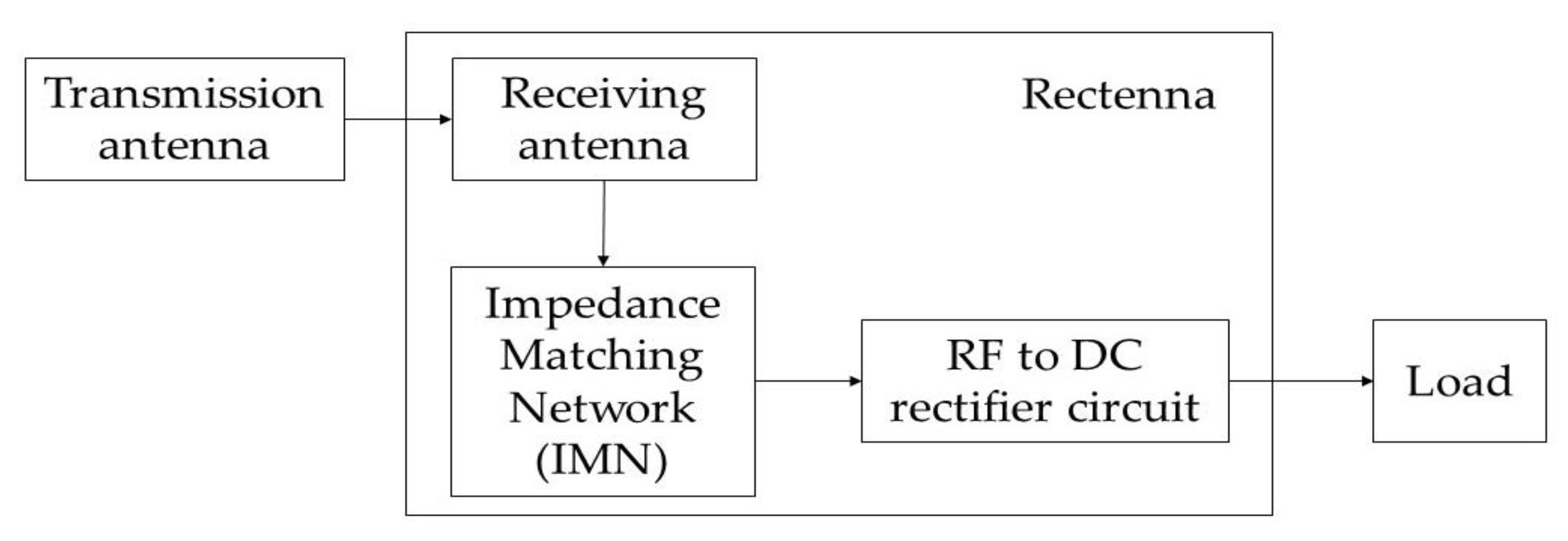
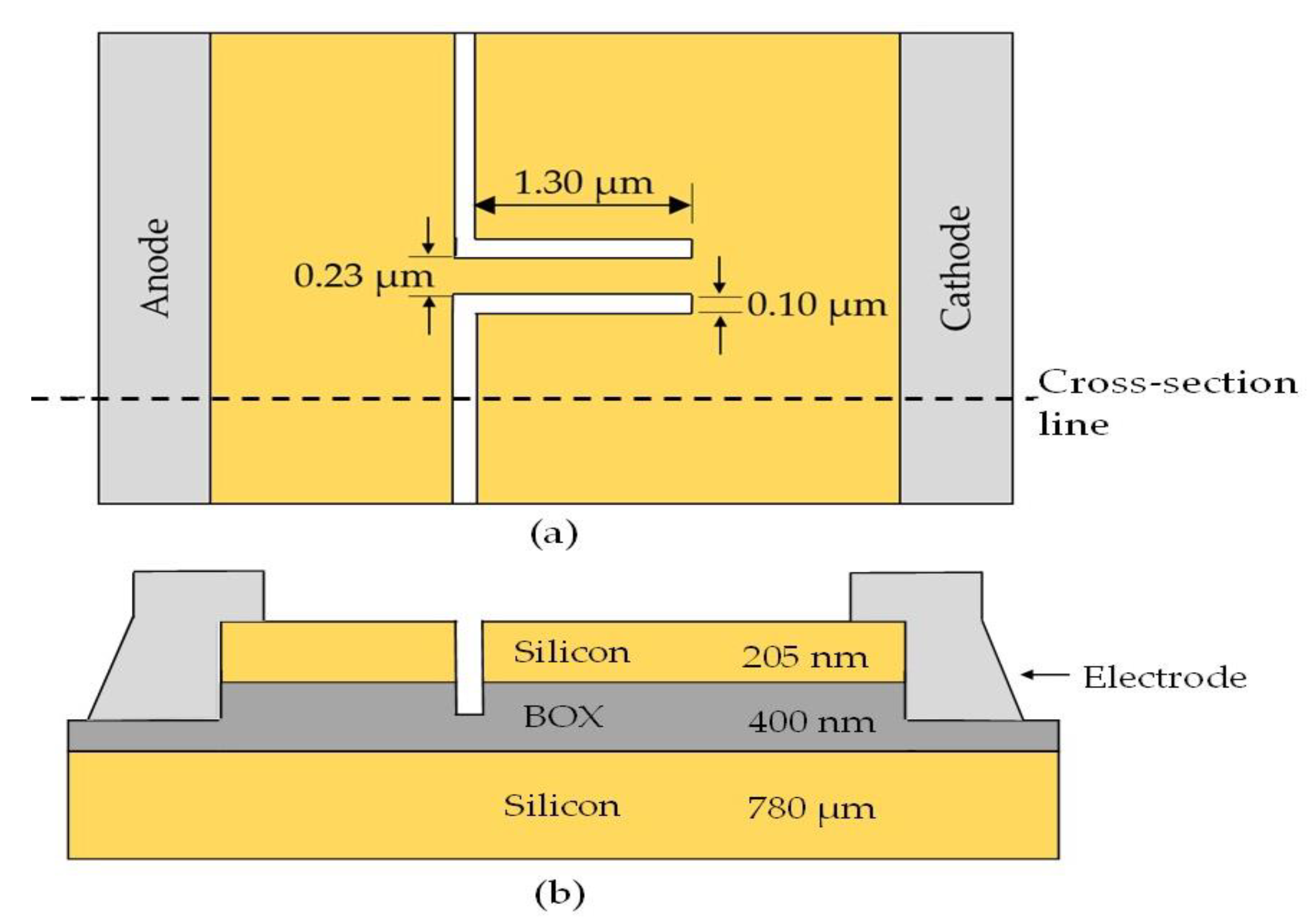
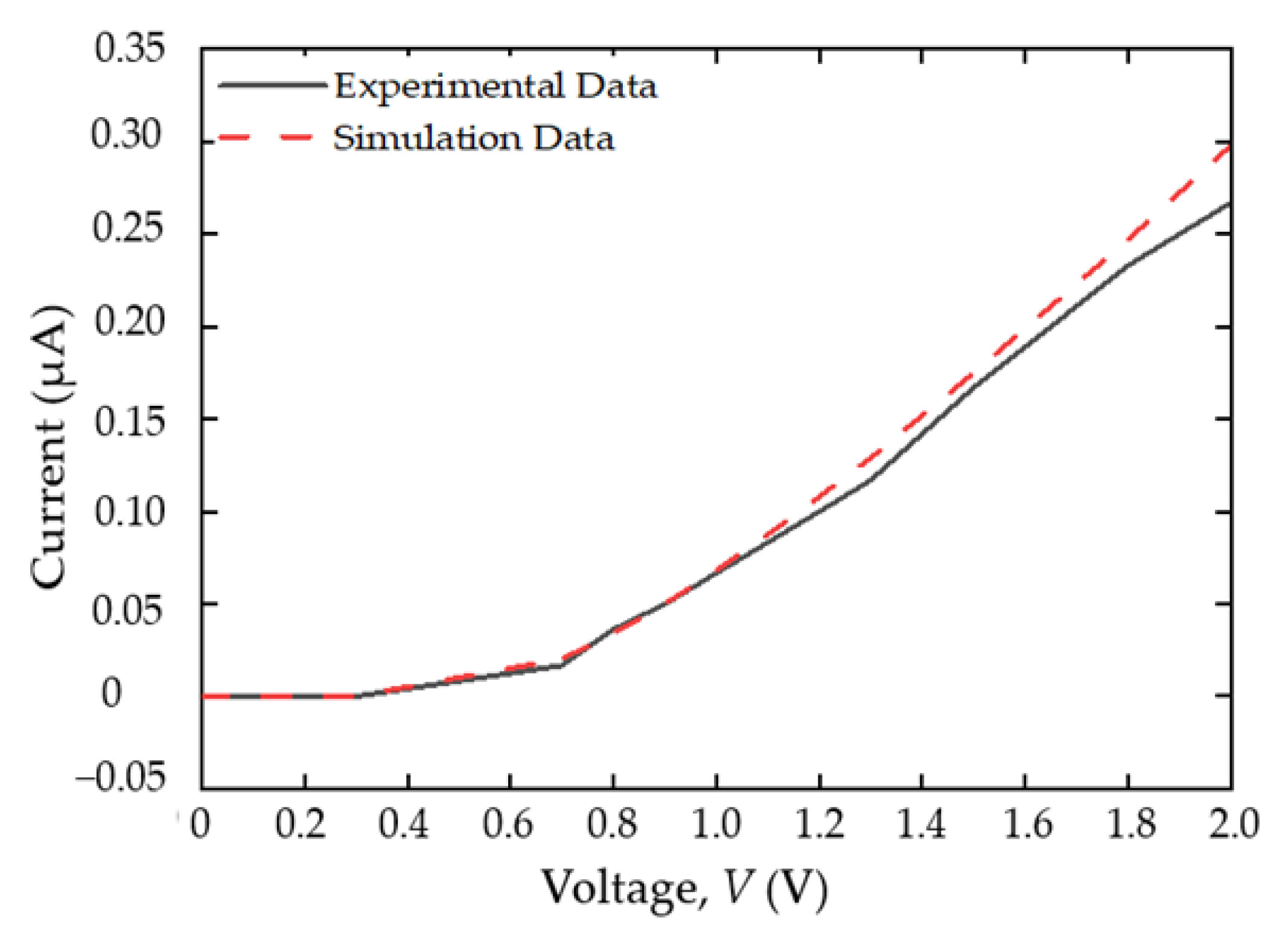
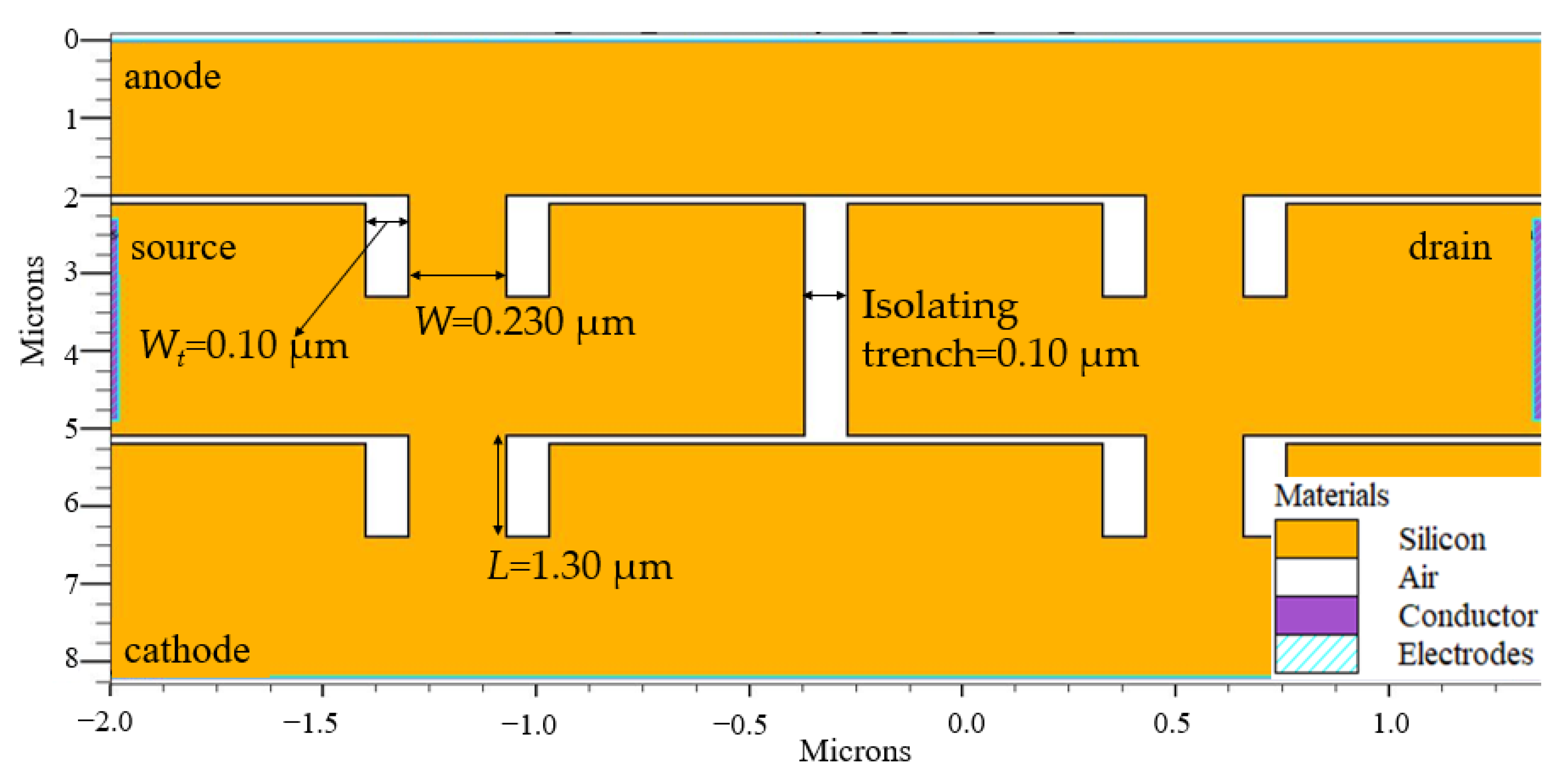
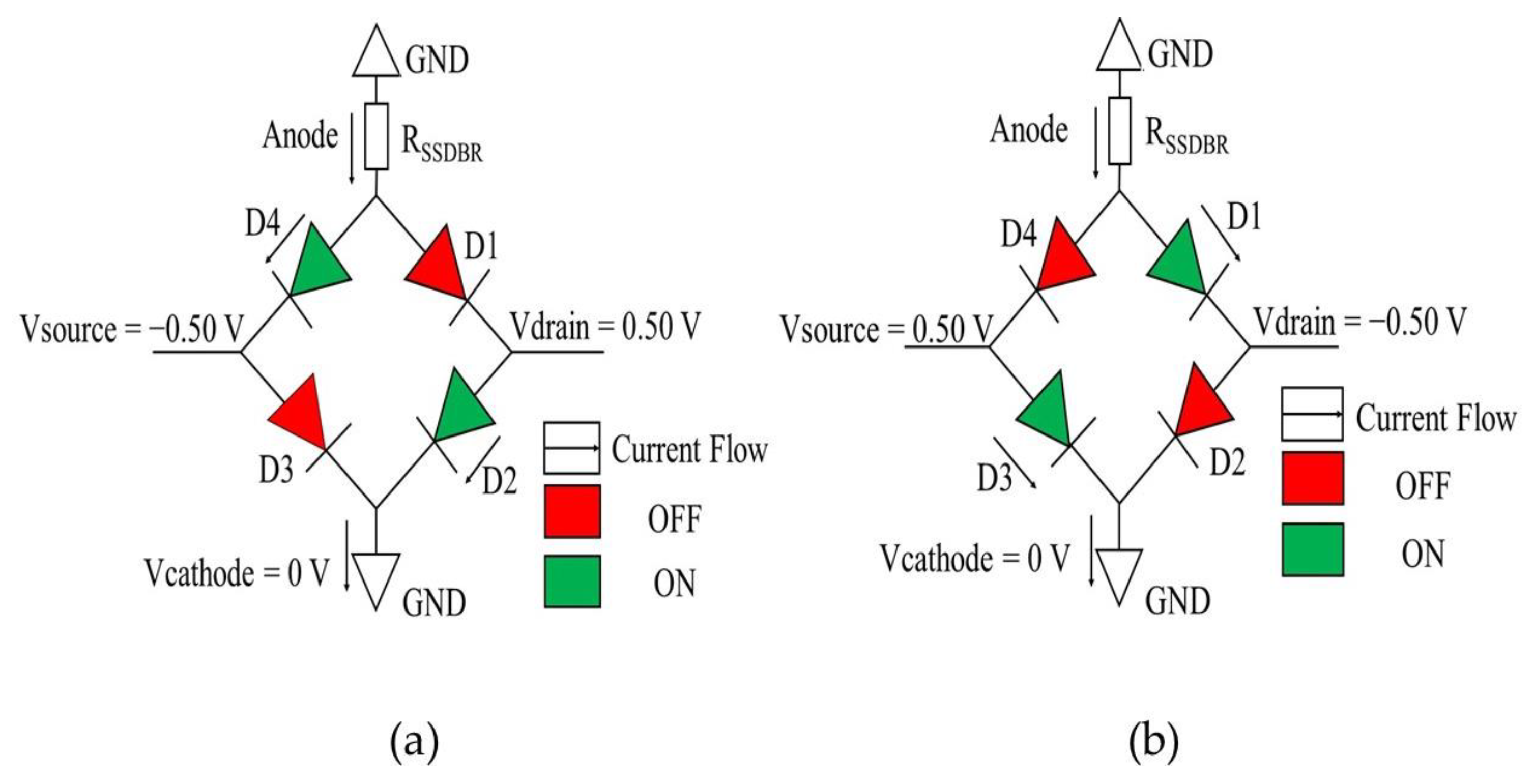



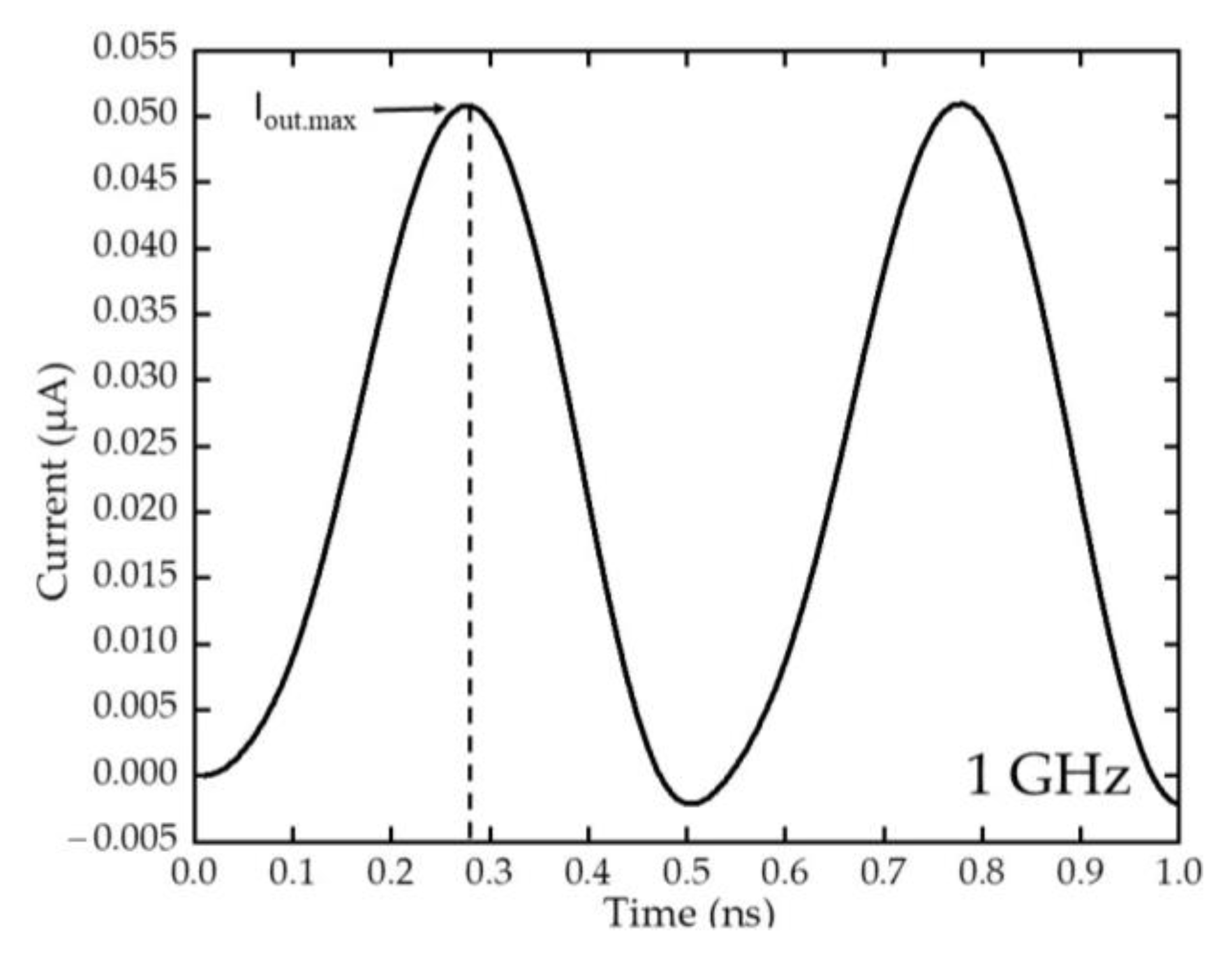
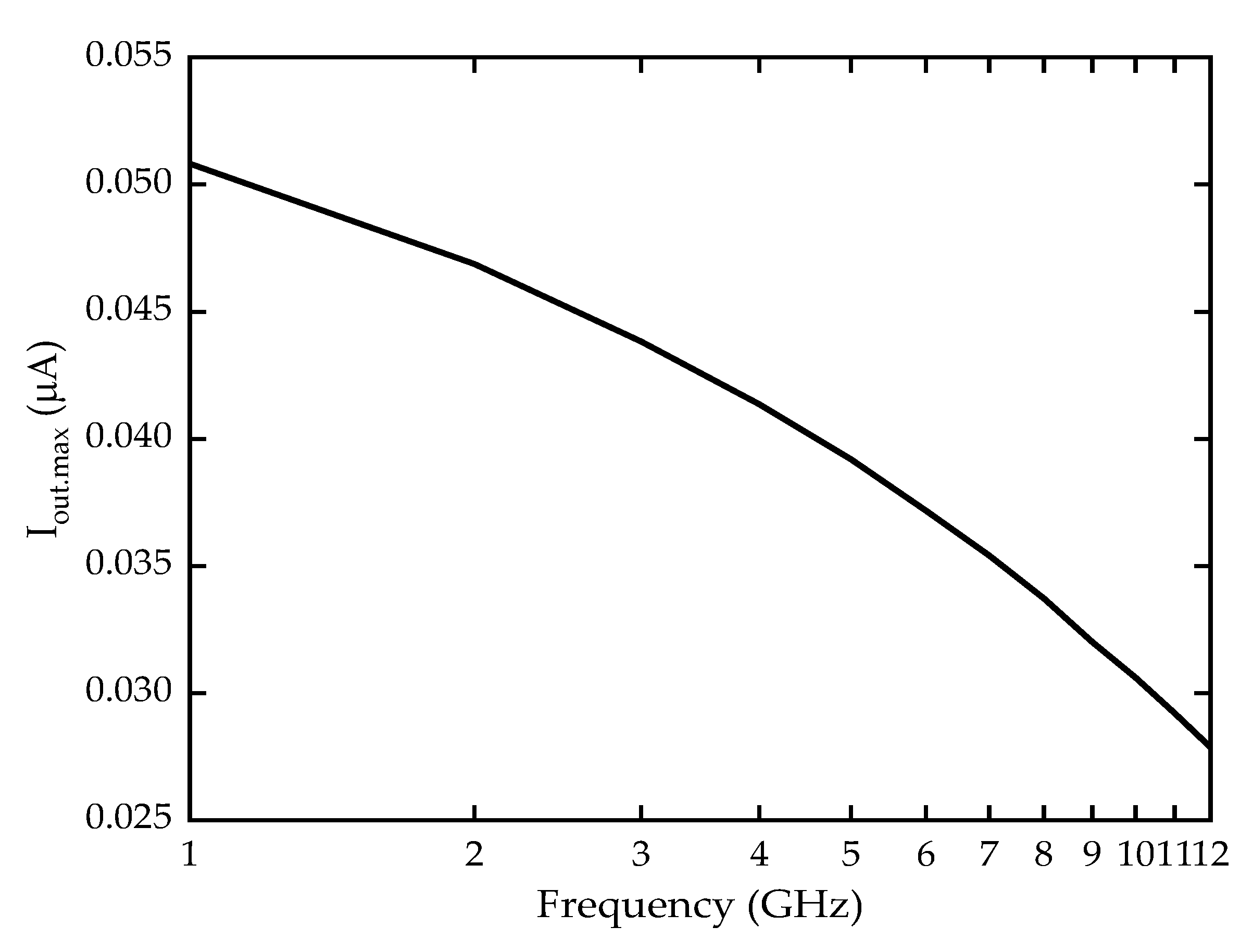


| Capacitance | Applied Equation No | Parameter Values |
|---|---|---|
| CSSD | 4 | a = 0.115 µm, b = 0.215 µm, c = 0.715 µm |
| 6 | s = 2.0 µm, d = 0.10 µm | |
| Ctrench | 4 | s = 1.63 µm, d = 0.10 µm |
| 5 | s = 2.0 µm, d = 3.40 µm |
Publisher’s Note: MDPI stays neutral with regard to jurisdictional claims in published maps and institutional affiliations. |
© 2022 by the authors. Licensee MDPI, Basel, Switzerland. This article is an open access article distributed under the terms and conditions of the Creative Commons Attribution (CC BY) license (https://creativecommons.org/licenses/by/4.0/).
Share and Cite
Yi Liang, T.; Zakaria, N.F.; Kasjoo, S.R.; Shaari, S.; Mohamad Isa, M.; Md Arshad, M.K.; Singh, A.K. Silicon Self-Switching Diode (SSD) as a Full-Wave Bridge Rectifier in 5G Networks Frequencies. Sensors 2022, 22, 9712. https://doi.org/10.3390/s22249712
Yi Liang T, Zakaria NF, Kasjoo SR, Shaari S, Mohamad Isa M, Md Arshad MK, Singh AK. Silicon Self-Switching Diode (SSD) as a Full-Wave Bridge Rectifier in 5G Networks Frequencies. Sensors. 2022; 22(24):9712. https://doi.org/10.3390/s22249712
Chicago/Turabian StyleYi Liang, Tan, Nor Farhani Zakaria, Shahrir Rizal Kasjoo, Safizan Shaari, Muammar Mohamad Isa, Mohd Khairuddin Md Arshad, and Arun Kumar Singh. 2022. "Silicon Self-Switching Diode (SSD) as a Full-Wave Bridge Rectifier in 5G Networks Frequencies" Sensors 22, no. 24: 9712. https://doi.org/10.3390/s22249712






